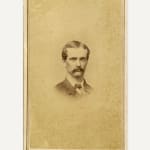[USS Lackawanna]
Group of CDV Portraits of Crewmembers Stationed in Hawaii, c. 1868
Albumen prints (14)
Each 3 1/2 x 2 1/2 inches
Most with photographer's backmark and subject identification and / or signature verso.
Most with photographer's backmark and subject identification and / or signature verso.
Further images
A rare group of CDV portraits of crewmembers of the USS Lackawanna, created when the ship was stationed in Hawaii in 1868. The collection pertains to a fascinating, largely-forgotten chapter...
A rare group of CDV portraits of crewmembers of the USS Lackawanna, created when the ship was stationed in Hawaii in 1868. The collection pertains to a fascinating, largely-forgotten chapter in 19th-century Hawaiian history - the Lackawanna Affair.
The Lackawanna Affair was an incident that occurred in the Hawaiian Islands in 1868. In response to concerns of imminent French occupation in Hawaii, the United States stationed the U.S.S. Lackawanna in Honolulu in 1867, seemingly as a surveillance mission to keep tabs on the growing tensions there. A year into the ship’s stay, the captain’s clerk George W. Lendeveg wrote to the Hawaiian monarch Kamehameha V claiming the ship’s purpose was actually part of a plot led by the ship’s captain, William Reynolds, to annex Hawaii to the United States. He named several co-conspirators that included some of Kamehameha V’s own advisors. Lendeveg’s claims played into the fears already swirling in the Hawaiian Government of US occupation, so Lendeveg was granted an audience and his accusations were investigated.
Lendeveg made certain demands in return for his information including at least fifteen-hundred dollars and a position in the Hawaiian government. While Lendeveg’s assertions were certainly in line with growing sentiments within the US government that Hawaii should be annexed, and probably reflected conversations he was privy to aboard the ship, whether these constituted an outright conspiracy is unclear. Nevertheless, his information became an important bargaining chip for Hawaii in securing its independence for the time being. His letters were reported to the Secretary of State, and the Hawaiian government rejected his allegations in an effort to demonstrate its loyalty to the US. Lendeveg was subsequently courtmartialed and while he was originally sentenced to 10 years at hard labor, his sentence was eventually rescinded, perhaps in an effort to erase the claims of the conspiracy all together.
Included in the collection is an unrecorded, signed portrait of Lendeveg, an earlier portrait of Francis L. Cooper, compiler of the photos, and portraits of the following crewmembers: JK Stevenson - Assistant engineer; Edward May - Paymaster; William Mead - Midshipman (2 photos); E.A. Roderick - Acting Master; E.S. Houston - Midshipman; William Reber - Surgeon; T.M. Jones - Third Assistant engineer; L.A. Kingsley - Boatswain; one unidentified portrait of a young man; one portrait identified as “one of our messengers”; and one portrait signed “H.L.H (?).”
Five of the photographs were taken by Bradley and Rulofson in San Francisco and seven by H.L. Chase in Hawaii.
The Lackawanna Affair was an incident that occurred in the Hawaiian Islands in 1868. In response to concerns of imminent French occupation in Hawaii, the United States stationed the U.S.S. Lackawanna in Honolulu in 1867, seemingly as a surveillance mission to keep tabs on the growing tensions there. A year into the ship’s stay, the captain’s clerk George W. Lendeveg wrote to the Hawaiian monarch Kamehameha V claiming the ship’s purpose was actually part of a plot led by the ship’s captain, William Reynolds, to annex Hawaii to the United States. He named several co-conspirators that included some of Kamehameha V’s own advisors. Lendeveg’s claims played into the fears already swirling in the Hawaiian Government of US occupation, so Lendeveg was granted an audience and his accusations were investigated.
Lendeveg made certain demands in return for his information including at least fifteen-hundred dollars and a position in the Hawaiian government. While Lendeveg’s assertions were certainly in line with growing sentiments within the US government that Hawaii should be annexed, and probably reflected conversations he was privy to aboard the ship, whether these constituted an outright conspiracy is unclear. Nevertheless, his information became an important bargaining chip for Hawaii in securing its independence for the time being. His letters were reported to the Secretary of State, and the Hawaiian government rejected his allegations in an effort to demonstrate its loyalty to the US. Lendeveg was subsequently courtmartialed and while he was originally sentenced to 10 years at hard labor, his sentence was eventually rescinded, perhaps in an effort to erase the claims of the conspiracy all together.
Included in the collection is an unrecorded, signed portrait of Lendeveg, an earlier portrait of Francis L. Cooper, compiler of the photos, and portraits of the following crewmembers: JK Stevenson - Assistant engineer; Edward May - Paymaster; William Mead - Midshipman (2 photos); E.A. Roderick - Acting Master; E.S. Houston - Midshipman; William Reber - Surgeon; T.M. Jones - Third Assistant engineer; L.A. Kingsley - Boatswain; one unidentified portrait of a young man; one portrait identified as “one of our messengers”; and one portrait signed “H.L.H (?).”
Five of the photographs were taken by Bradley and Rulofson in San Francisco and seven by H.L. Chase in Hawaii.
![[USS Lackawanna], Group of CDV Portraits of Crewmembers Stationed in Hawaii, c. 1868](https://artlogic-res.cloudinary.com/w_1600,h_1600,c_limit,f_auto,fl_lossy,q_auto/artlogicstorage/dollc/images/view/149c7142d7e51fd0d56fdf3cc1a7b8a3j/daniel-oliver-uss-lackawanna-group-of-cdv-portraits-of-crewmembers-stationed-in-hawaii-c.-1868.jpg)
![[USS Lackawanna], Group of CDV Portraits of Crewmembers Stationed in Hawaii, c. 1868](https://artlogic-res.cloudinary.com/w_1600,h_1600,c_limit,f_auto,fl_lossy,q_auto/artlogicstorage/dollc/images/view/085686ed4ae5dff3992239c9b140df51j/daniel-oliver-uss-lackawanna-group-of-cdv-portraits-of-crewmembers-stationed-in-hawaii-c.-1868.jpg)
![[USS Lackawanna], Group of CDV Portraits of Crewmembers Stationed in Hawaii, c. 1868](https://artlogic-res.cloudinary.com/w_1600,h_1600,c_limit,f_auto,fl_lossy,q_auto/artlogicstorage/dollc/images/view/2b3d57407c085019a0f90457ef821a76j/daniel-oliver-uss-lackawanna-group-of-cdv-portraits-of-crewmembers-stationed-in-hawaii-c.-1868.jpg)
![[USS Lackawanna], Group of CDV Portraits of Crewmembers Stationed in Hawaii, c. 1868](https://artlogic-res.cloudinary.com/w_1600,h_1600,c_limit,f_auto,fl_lossy,q_auto/artlogicstorage/dollc/images/view/ba939ceb76415cc28d710226909a0021j/daniel-oliver-uss-lackawanna-group-of-cdv-portraits-of-crewmembers-stationed-in-hawaii-c.-1868.jpg)
![[USS Lackawanna], Group of CDV Portraits of Crewmembers Stationed in Hawaii, c. 1868](https://artlogic-res.cloudinary.com/w_1600,h_1600,c_limit,f_auto,fl_lossy,q_auto/artlogicstorage/dollc/images/view/82bafb962831b15a1064f78f8bda46f4j/daniel-oliver-uss-lackawanna-group-of-cdv-portraits-of-crewmembers-stationed-in-hawaii-c.-1868.jpg)
![[USS Lackawanna], Group of CDV Portraits of Crewmembers Stationed in Hawaii, c. 1868](https://artlogic-res.cloudinary.com/w_1600,h_1600,c_limit,f_auto,fl_lossy,q_auto/artlogicstorage/dollc/images/view/0a8d1c4825960b3e5035ef30dd1b1e76j/daniel-oliver-uss-lackawanna-group-of-cdv-portraits-of-crewmembers-stationed-in-hawaii-c.-1868.jpg)





